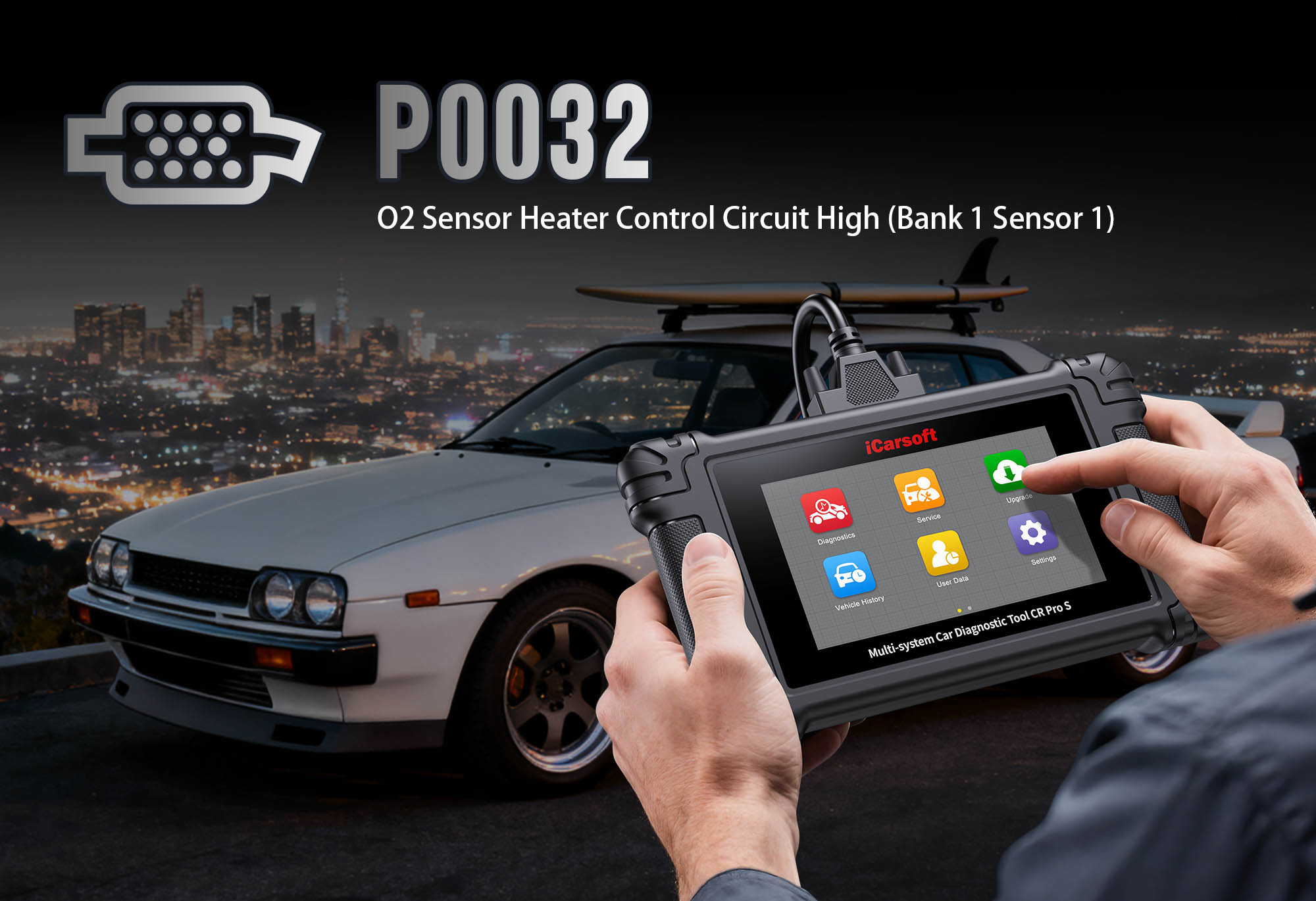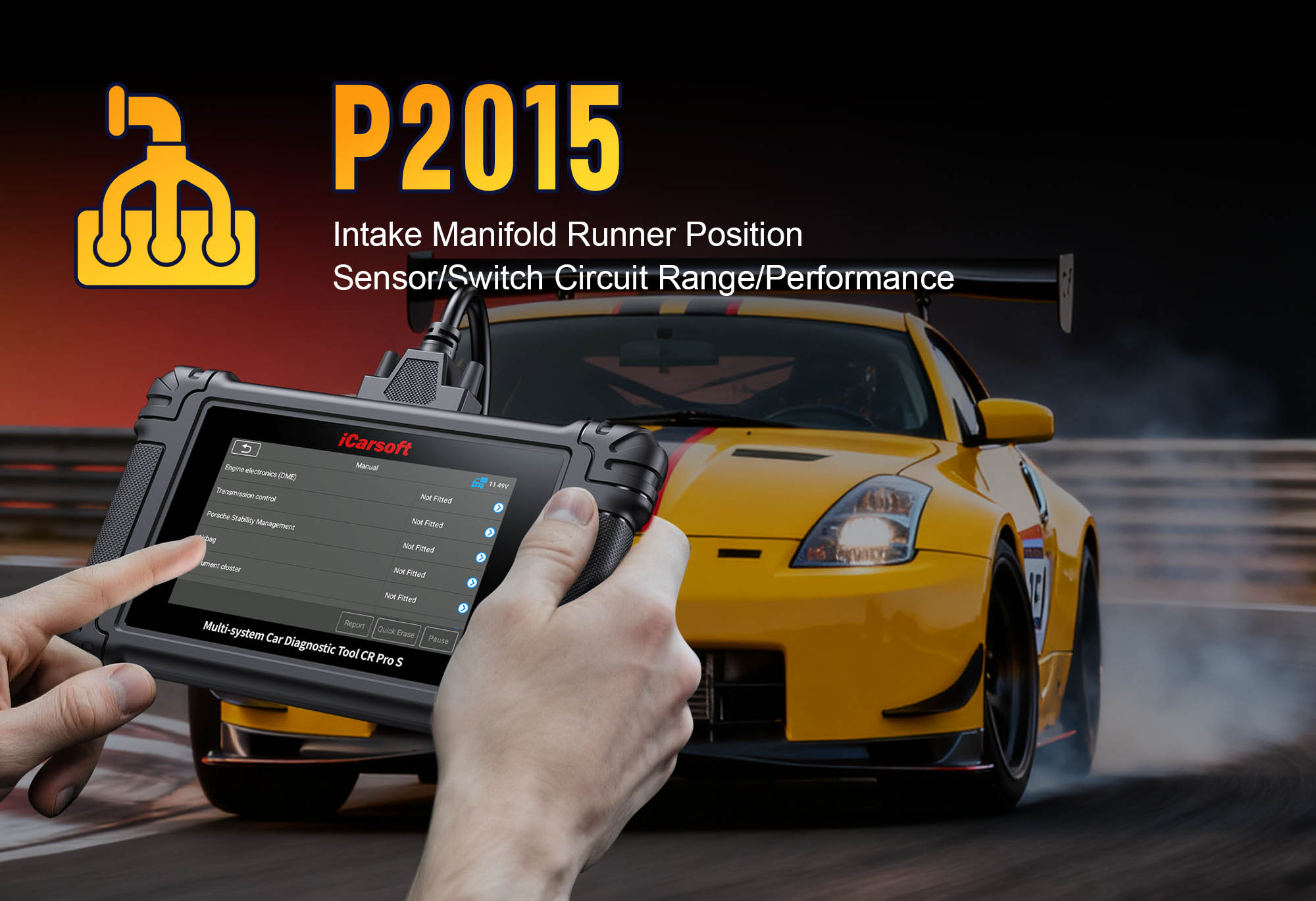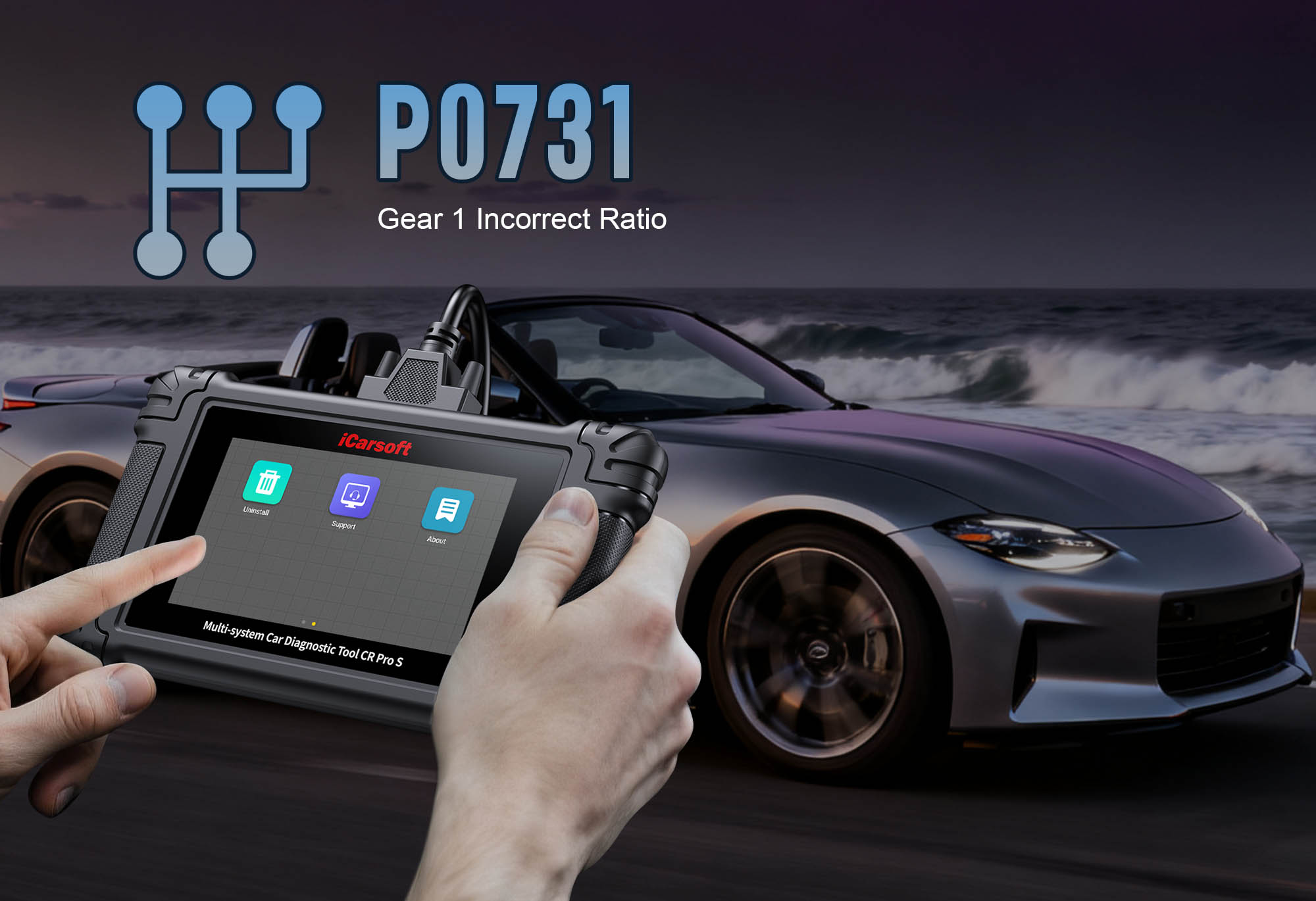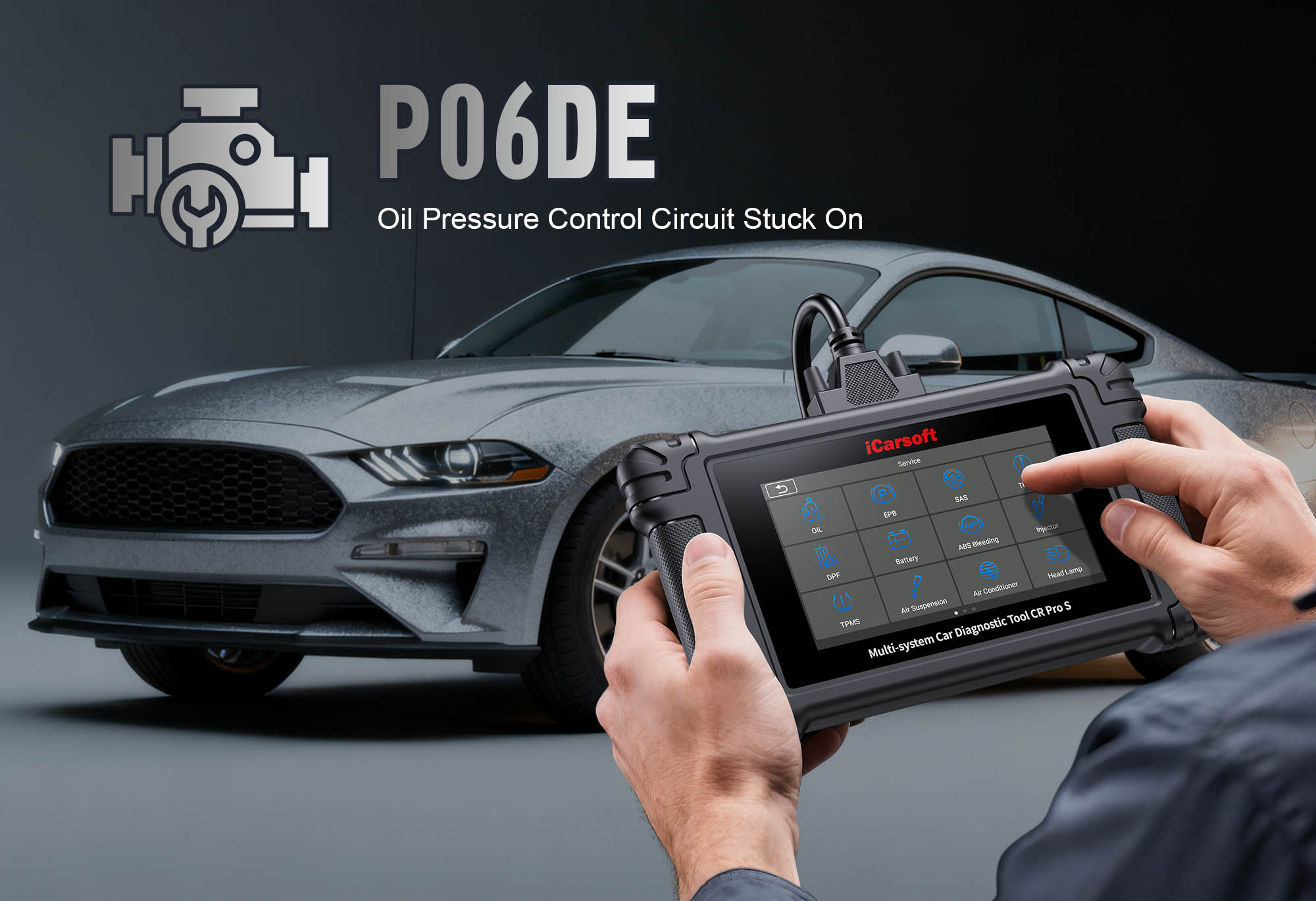P0032 Code: Diagnose & Clear O2 Sensor Heater Control Circuit High Voltage with iCarsoft CR Pro S
If your check engine light illuminates and you notice symptoms like poor fuel efficiency, rough idling, or increased exhaust emissions, a diagnostic scan will likely return P0032. This OBD-II code stands for "Oxygen (O2) Sensor Heater Control Circuit High Voltage," indicating the Engine Control Module (ECM) has detected an abnormally high voltage in the heater circuit of the upstream (pre-catalytic converter) O2 sensor.
O2 sensors regulate engine emissions and fuel delivery by measuring exhaust oxygen levels, sending signals to the ECM to adjust the air-fuel mixture. They rely on an internal heater to reach operating temperature (600–800°F) quickly—critical for accurate readings. The heater circuit, powered by the battery and controlled by the ECM, maintains this temperature. A "high voltage" error (>14.5V, vs. normal 12–14V) signals a spike or open circuit, preventing proper heating. Left unaddressed, P0032 causes failed emissions tests, catalytic converter damage, and fuel waste.
Basic scanners only flag "O2 sensor fault" but can’t separate heater circuit issues from sensor failure. The iCarsoft CR Pro S, with O2 sensor-specific diagnostics, live voltage tracking, and circuit tests, solves this. Let’s walk through precise diagnosis and resolution.
Understanding P0032: Causes & Key Symptoms
A faulty O2 sensor heater circuit disrupts sensor performance, with symptoms worsening as the sensor stays unheated—these clues help isolate electrical faults from sensor failure.
Key Symptoms of P0032
-
Poor Fuel Efficiency: Inaccurate O2 data makes the ECM misadjust the air-fuel mixture—fuel economy drops 15–20%.
-
Rough Idling: Engine shakes at 500–1,000 RPM as the ECM struggles to balance fuel delivery without reliable sensor data.
-
Delayed Warning Light: Check engine light illuminates 5–10 minutes after startup (ECM waits to detect heater issues).
-
Increased Emissions: Unregulated mixtures raise hydrocarbons (HC) and carbon monoxide (CO)—causing failed emissions tests.
-
Catalytic Converter Overheating: Rich fuel mixtures send unburned fuel to the converter, risking damage or fire.
-
Intermittent Lights: Light turns on/off, triggered by temperature (wiring expansion) or vibration (loose connectors).
Common Causes of P0032
|
Cause
|
Description
|
|
Faulty O2 Sensor Heater Element
|
Internal burnout of the heater coil (common in sensors >60,000 miles) creates an open circuit, leading to high voltage readings.
|
|
Wiring/Connector Issues
|
Frayed wires, corroded terminals, or loose plugs create resistance, causing voltage spikes in the heater circuit.
|
|
Short to Battery Voltage
|
A heater circuit wire touches a 12V power source (e.g., battery cable), sending constant high voltage to the ECM.
|
|
Faulty ECM Heater Driver
|
The ECM’s internal component controlling heater voltage fails, sending incorrect high signals.
|
|
Blown Heater Fuse
|
A dedicated O2 sensor heater fuse (in some vehicles) blows, creating an open circuit the ECM misinterprets as high voltage.
|
|
Water Intrusion
|
Moisture in the sensor connector (off-road/wet climates) corrodes pins and disrupts voltage flow.
|
Why iCarsoft CR Pro S Excels at Diagnosing P0032
The CR Pro S outperforms basic tools with O2 sensor heater-specific features, critical for isolating P0032’s root cause:
Live Heater Circuit Voltage Tracking
Monitors real-time voltage in the O2 sensor heater circuit, making spikes above 14.5V easy to identify.
O2 Sensor Heater Test
Manually activates the sensor’s heater to check current draw and temperature rise—verifies heater functionality.
Circuit Short/Continuity Tests
Measures wiring resistance and checks for short-to-battery faults—isolates electrical issues quickly.
Sensor Temperature Monitoring
Tracks O2 sensor operating temperature—confirms if the heater fails to reach 600–800°F.
Global Vehicle Coverage
Works with 500+ models (Ford, Toyota, Chevrolet, BMW, Mercedes-Benz) for O2 sensor placement variations.
ECM Heater Driver Tests
Verifies if the ECM sends correct voltage to the heater circuit—rules out internal ECM faults.
Step-by-Step: Diagnose P0032 with iCarsoft CR Pro S
-
Locate the Upstream O2 Sensor First
1. Navigate to Component Location > Engine > Emissions > Oxygen Sensors.
2. Identify the upstream sensor (Bank 1, Sensor 1): Mounted in the exhaust manifold or front pipe (before the catalytic converter).
3. Note the heater circuit wiring (2 wires, usually black/white or red/black) connecting the sensor to the ECM/battery.
-
Connect the CR Pro S & Confirm the Code
1. Plug into the OBD-II port (use OBDI adaptors for older models: Mercedes 38Pin, BMW 20Pin).
2. Select your vehicle via Auto VIN Identify (instant specs) or manual entry.
3. Navigate to Engine > Fault Codes > Read Codes to confirm P0032. Tap Code Details for tips (e.g., "Toyota Corolla: Check Heater Wiring & Sensor Resistance").
-
Check for Obvious Electrical Issues
1. Heater Fuse Inspection: Use Fuse Guide to locate the O2 sensor heater fuse (engine bay fuse box). Replace if blown (match amperage: 7.5A/10A).
2. Connector Inspection: Disconnect the upstream O2 sensor connector. Clean corrosion/bent pins with electrical contact cleaner.
-
Analyze Live Heater Circuit Data
1. Start the engine, idle 5 minutes (ECM activates the heater).
2. Navigate to Engine > Live Data > Emissions > O2 Sensor (Bank 1, Sensor 1) and monitor:
- Heater Voltage: Normal = 12–14V. P0032 = >14.5V or 0V (open circuit).
- Sensor Temperature: Normal = 600–800°F. <500°F = heater not working.
- Heater Current Draw: Normal = 0.5–1.5A. 0A = open circuit; >2A = shorted element.
- ECM Heater Signal: Look for steady PWM pulses. No pulses = ECM driver fault.
-
Test the O2 Sensor Heater Element
1. Turn off the engine, disconnect the sensor connector.
2. Use Multimeter Function to measure resistance between the two heater wires (labeled "HEATER+"/"HEATER-").
3. Compare to specs:
- Normal = 1–10 ohms.
- Infinite resistance = heater burnout (replace sensor).
- <1 ohm = shorted element (replace sensor).
-
Test the Heater Circuit for Shorts & Continuity
1. Short-to-Battery Test: Measure voltage between heater power wire and ground (disconnected). 12V = shorted to battery (repair wiring).
2. Continuity Test: Measure resistance between sensor heater wire and ECM pin (use wiring diagram). Normal = <5 ohms. Higher = frayed wire/corrosion.
3. Ground Test: Measure resistance between sensor ground wire and chassis. Normal = <1 ohm. Higher = bad ground.
-
Perform Bi-Directional Heater Activation Test
1. Navigate to Special Functions > Engine > Emissions > O2 Sensor Heater Test.
2. Select Activate Heater—CR Pro S commands the ECM to turn on the heater.
3. Monitor:
- Voltage drops to 12–14V = ECM works. No change = ECM driver fault (consult pro).
- Temperature rises 100–200°F in 2 minutes = heater works. No rise = wiring/sensor fault.
-
Rule Out ECM Issues
1. ECM Communication Test: Go to System > ECM Communication Check—verify signal flow. Failed = ECM repair.
2. ECM Firmware Update: Install free updates via Update Manager—fixes misinterpreted heater signals.
-
Repair & Clear P0032
1. Fix the root cause:
- Faulty Sensor: Replace upstream O2 sensor (use Part Lookup for OEM compatibility).
- Wiring Issues: Repair shorts, frayed wires, or corroded connectors.
- Blown Fuse: Replace O2 sensor heater fuse.
- ECM Fault: Update firmware or consult a professional.
2. Clear the code: Navigate to Engine > Fault Codes > Clear Codes to delete P0032.
-
Validate the Repair
1. Recheck live data: Heater voltage = 12–14V; sensor temperature = 600–800°F within 5 minutes.
2. Test drive 30–40 minutes (highway + city): No rough idle, poor fuel efficiency, or warnings.
3. Post-drive scan: Use Emissions System Scan after 50 miles to confirm P0032 doesn’t return.
4. (Optional) Run Emissions Check to verify HC/CO levels are legal.
Preventing P0032 Recurrence
Use the iCarsoft CR Pro S to maintain O2 sensor and heater circuit health long-term:
-
Sensor Maintenance: Set Service Reminder to replace upstream O2 sensors every 60,000–100,000 miles (sooner in stop-and-go traffic).
-
Wiring Checks: Include heater circuit continuity tests in annual electrical scans—catch frayed wires early.
-
Fuse Inspections: Check the heater fuse every 30,000 miles—replace if worn (even if not blown).
-
Water Protection: Apply dielectric grease to the sensor connector after cleaning to prevent moisture intrusion.
Conclusion
P0032’s O2 sensor heater circuit high voltage fault disrupts emissions control and wastes fuel—but the iCarsoft CR Pro S simplifies diagnosis with live voltage tracking, heater tests, and circuit checks. Whether replacing a faulty sensor, fixing wiring, or updating the ECM, this tool ensures you address the root cause (not just the symptom).
With the CR Pro S, you’ll restore accurate O2 sensor readings, boost fuel efficiency, and pass emissions tests—no more costly catalytic converter damage or unnecessary sensor replacements.
FAQs About P0032 Code
Q: Can I drive with P0032?
A: Short trips (to a repair shop) are safe, but prolonged driving causes fuel waste and catalytic converter damage. Fix P0032 within 1–2 weeks.
Q: How much does it cost to fix P0032?
A: $80–$250 for an OEM O2 sensor; $50–$150 for wiring/connector repairs; $400–$1,000 for ECM repairs. The CR Pro S saves by avoiding unnecessary ECM replacement.
Q: Will replacing the O2 sensor fix P0032?
A: Yes—if P0032 is caused by a faulty heater element. If the issue is wiring or ECM, a new sensor won’t help (use the CR Pro S to diagnose first).
Q: What’s the difference between P0032 and P0031?
A: P0032 = "Heater Circuit High Voltage," while P0031 = "Heater Circuit Low Voltage." The CR Pro S distinguishes them via live voltage data (high vs. low readings).





